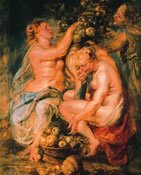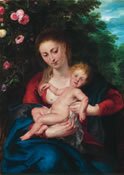Inflight Magazine of Brussels Airlines
Welcome to the Inflight Magazine of Brussels Airlines
Rediscovering Rubens
A new Rubens exhibition in Brussels aims to shed light on the Flemish master. Renée Cordes offers a preview
 In the dimly lit backrooms of Brussels’ Royal Museums of Fine Arts, Hélène Dubois is painstakingly dabbing small bits of paint on to a masterpiece by Peter Paul Rubens. “With Rubens, you have to be patient,” she explains.
In the dimly lit backrooms of Brussels’ Royal Museums of Fine Arts, Hélène Dubois is painstakingly dabbing small bits of paint on to a masterpiece by Peter Paul Rubens. “With Rubens, you have to be patient,” she explains.
Dubois is a member of the team tasked with restoring works by the Flemish baroque master for an exhibition starting this month. The idea for the exhibition came from a research project funded by Belgium’s Federal Public Service of Scientific Policy Planning in collaboration with the internationally acclaimed Rubenianum, based in Antwerp, and the National Institute of Artistic Heritage.
 Four researchers, including Dubois, and curators Sabine van Sprang and Joost Vander Auwera were charged with studying the Royal Museums’ collection of about 50 works, either painted by Rubens (1577–1640) or completed in collaboration with his studio in Antwerp.
Four researchers, including Dubois, and curators Sabine van Sprang and Joost Vander Auwera were charged with studying the Royal Museums’ collection of about 50 works, either painted by Rubens (1577–1640) or completed in collaboration with his studio in Antwerp.
As part of the project, they conducted an in-depth analysis of each work by means of x-rays and a so-called ‘stratigraphic’ study of individual layers of paint. This research had some great results. For example, it helped the team to confirm the belief that Rubens’ ‘Four Negro Heads’ was actually one man’s head from four different angles – and that it was used as the basis for one of the three kings in his ‘Adoration of the Magi’. To be historically and politically correct, it was renamed ‘Four Studies of the Head of a Moor’.
 This and other fascinating results of the project will be on display in ‘Rubens: A Genius at Work’, comprising 50 paintings from the permanent collection and almost 70 others on loan from famous institutions including the Louvre, Paris; the Prado, Madrid; and New York’s Metropolitan Museum of Art, as well as a handful from private collections.
This and other fascinating results of the project will be on display in ‘Rubens: A Genius at Work’, comprising 50 paintings from the permanent collection and almost 70 others on loan from famous institutions including the Louvre, Paris; the Prado, Madrid; and New York’s Metropolitan Museum of Art, as well as a handful from private collections.
“It isn’t a classical Rubens exhibition, but a way of showing how he worked,” says Van Sprang. In other words, even those familiar with Rubens should learn something from the exhibition, the Royal Museums’ first in more than three decades to concentrate on Antwerp’s most famous son.
“We also tried to make a beautiful exhibition,” Van Sprang adds, paying homage to the in-depth restoration of five Rubens paintings, including ‘The Madonna with the Periwinkle’ and ‘Christ and the Adulteress’, thanks to funding from the InBev Baillet-Latour Foundation.
 The exhibition is divided into six sections, each devoted to a different aspect of the atelier. It seeks to shed light on Rubens’ creative processes, by displaying a sketch or study alongside a larger painting or altarpiece. Researchers learned Rubens kept originals of some portraits in his studio to serve as templates for other works. Unfortunately, these originals are often in poor condition and a restorer’s nightmare.
The exhibition is divided into six sections, each devoted to a different aspect of the atelier. It seeks to shed light on Rubens’ creative processes, by displaying a sketch or study alongside a larger painting or altarpiece. Researchers learned Rubens kept originals of some portraits in his studio to serve as templates for other works. Unfortunately, these originals are often in poor condition and a restorer’s nightmare.
In some cases, the research revealed that works previously attributed to Rubens may actually have been the work of another artist. “The idea of the research project was to re-evaluate our own collection and ask of each painting, is this Rubens or not?” says Van Sprang.
The exhibition also hopes to help the public gain added appreciation for, and understanding of, the work of Rubens and those influenced by him. It features some Rubens co-productions with Jan Brueghel the Elder and other renowned colleagues. It also includes works that Rubens, ever the entrepreneur, subcontracted to other painters.
Visitors will be able to draw their own conclusions about Rubens, aided by an audiovisual guide (available in French, Dutch or English) and a booklet showing x-ray images or other details of the works on display. Two of the museum’s rooms were renovated especially for the event, with new lighting and a fresh lick of paint.
A thorough, illustrated exhibition catalogue will be available from the gift shop, offering opportunities for further study. Along with essays by the researchers, the book will include contributions by noted Rubens scholars and catalogue each of the works on display. The findings will also be incorporated into a database.
Referring to Rubens as an “intellectual painter”, Van Sprang notes that through art – and in particular the work of past masters – he was on a quest to determine, “Where do I fit into the story?” The exhibition seeks to answer that question.
Leave a Reply
